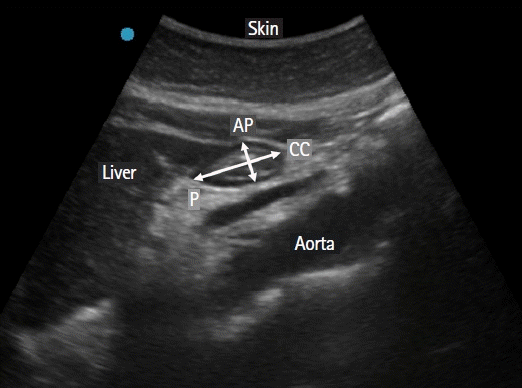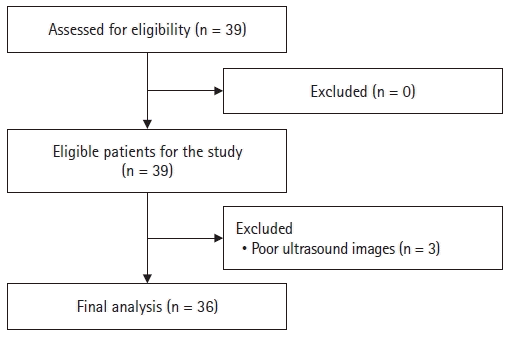1. Practice guidelines for preoperative fasting and the use of pharmacologic agents to reduce the risk of pulmonary aspiration: application to healthy patients undergoing elective procedures: an updated report by the American Society of Anesthesiologists task force on preoperative fasting and the use of pharmacologic agents to reduce the risk of pulmonary aspiration. Anesthesiology. 2017; 126:376–93.
2. Hellstrom PM, Samuelsson B, Al-Ani AN, Hedstrom M. Normal gastric emptying time of a carbohydrate-rich drink in elderly patients with acute hip fracture: a pilot study. BMC Anesthesiol. 2017; 17:23.
3. Leviter J, Steele DW, Constantine E, Linakis JG, Amanullah S. “Full stomach” despite the wait: point-of-care gastric ultrasound at the time of procedural sedation in the pediatric emergency department. Acad Emerg Med. 2019; 26:752–60.
4. Dupont G, Gavory J, Lambert P, Tsekouras N, Barbe N, Presles E, et al. Ultrasonographic gastric volume before unplanned surgery. Anaesthesia. 2017; 72:1112–6.
5. Chang JE, Kim H, Won D, Lee JM, Jung JY, Min SW, et al. Ultrasound assessment of gastric content in fasted patients before elective laparoscopic cholecystectomy: a prospective observational single-cohort study. Can J Anaesth. 2020; 67:810–6.
6. Moore JG, Tweedy C, Christian PE, Datz FL. Effect of age on gastric emptying of liquid--solid meals in man. Dig Dis Sci. 1983; 28:340–4.
7. Leslie JB, Viscusi ER, Pergolizzi JV Jr, Panchal SJ. Anesthetic routines: the anesthesiologist’s role in GI recovery and postoperative ileus. Adv Prev Med. 2011; 2011:976904.
8. Dahl JB, Mathiesen O, Kehlet H. An expert opinion on postoperative pain management, with special reference to new developments. Expert Opin Pharmacother. 2010; 11:2459–70.
9. Bouvet L, Barnoud S, Desgranges FP, Chassard D. Effect of body position on qualitative and quantitative ultrasound assessment of gastric fluid contents. Anaesthesia. 2019; 74:862–7.
10. Cubillos J, Tse C, Chan VW, Perlas A. Bedside ultrasound assessment of gastric content: an observational study. Can J Anaesth. 2012; 59:416–23.
11. Perlas A, Mitsakakis N, Liu L, Cino M, Haldipur N, Davis L, et al. Validation of a mathematical model for ultrasound assessment of gastric volume by gastroscopic examination. Anesth Analg. 2013; 116:357–63.
12. Perlas A, Davis L, Khan M, Mitsakakis N, Chan VW. Gastric sonography in the fasted surgical patient: a prospective descriptive study. Anesth Analg. 2011; 113:93–7.
13. Van de Putte P, Perlas A. Ultrasound assessment of gastric content and volume. Br J Anaesth. 2014; 113:12–22.
14. Perlas A, Van de Putte P, Van Houwe P, Chan VW. I-AIM framework for point-of-care gastric ultrasound. Br J Anaesth. 2016; 116:7–11.
15. Shin HJ, Koo BW, Lim D, Na HS. Ultrasound assessment of gastric volume in older adults after drinking carbohydrate-containing fluids: a prospective, nonrandomized, and noninferiority comparative study. Can J Anaesth. 2022; 69:1160–6.
16. Jeong JY, Ahn JH, Shim JG, Lee SH, Ryu KH, Lee SH, et al. Gastric emptying of preoperative carbohydrate in elderly assessed using gastric ultrasonography: a randomized controlled study. Medicine (Baltimore). 2021; 100:e27242.
17. Ohashi Y, Walker JC, Zhang F, Prindiville FE, Hanrahan JP, Mendelson R, et al. Preoperative gastric residual volumes in fasted patients measured by bedside ultrasound: a prospective observational study. Anaesth Intensive Care. 2018; 46:608–13.
18. Zhang Z, Wang RK, Duan B, Cheng ZG, Wang E, Guo QL, et al. Effects of a preoperative carbohydrate-rich drink before ambulatory surgery: a randomized controlled, double-blinded study. Med Sci Monit. 2020; 26:e922837.
19. Camilleri M, Chedid V, Ford AC, Haruma K, Horowitz M, Jones KL, et al. Gastroparesis. Nat Rev Dis Primers. 2018; 4:41.
20. Woodhouse S, Hebbard G, Knowles SR. Psychological controversies in gastroparesis: a systematic review. World J Gastroenterol. 2017; 23:1298–309.
21. Desborough JP. The stress response to trauma and surgery. Br J Anaesth. 2000; 85:109–17.
22. Zigmond AS, Snaith RP. The hospital anxiety and depression scale. Acta Psychiatr Scand. 1983; 67:361–70.
23. Wolmeister AS, Schiavo CL, Nazario KC, Castro SM, de Souza A, Caetani RP, et al. The brief measure of emotional preoperative stress (B-MEPS) as a new predictive tool for postoperative pain: a prospective observational cohort study. PLoS One. 2020; 15:e0227441.
24. Kim YH, Choi WJ. Effect of preoperative anxiety on spectral entropy during induction with propofol. Korean J Anesthesiol. 2013; 65:108–13.
25. Cohen S, Kamarck T, Mermelstein R. A global measure of perceived stress. J Health Soc Behav. 1983; 24:385–96.
26. Haroutounian S. Postoperative opioids, endocrine changes, and immunosuppression. Pain Rep. 2018; 3:e640.
27. Hohenschurz-Schmidt DJ, Calcagnini G, Dipasquale O, Jackson JB, Medina S, O’Daly O, et al. Linking pain sensation to the autonomic nervous system: the role of the anterior cingulate and periaqueductal gray resting-state networks. Front Neurosci. 2020; 14:147.
28. Kapritsou M, Papathanassoglou ED, Bozas E, Korkolis DP, Konstantinou EA, Kaklamanos I, et al. Comparative evaluation of pain, stress, neuropeptide Y, ACTH, and cortisol levels between a conventional postoperative care protocol and a fast-track recovery program in patients undergoing major abdominal surgery. Biol Res Nurs. 2017; 19:180–9.
29. Browning KN, Travagli RA. Central nervous system control of gastrointestinal motility and secretion and modulation of gastrointestinal functions. Compr Physiol. 2014; 4:1339–68.
30. Sobczak M, Salaga M, Storr MA, Fichna J. Physiology, signaling, and pharmacology of opioid receptors and their ligands in the gastrointestinal tract: current concepts and future perspectives. J Gastroenterol. 2014; 49:24–45.
31. Yuan CS, Foss JF, O’Connor M, Roizen MF, Moss J. Effects of low-dose morphine on gastric emptying in healthy volunteers. J Clin Pharmacol. 1998; 38:1017–20.





 PDF
PDF Citation
Citation Print
Print




 XML Download
XML Download